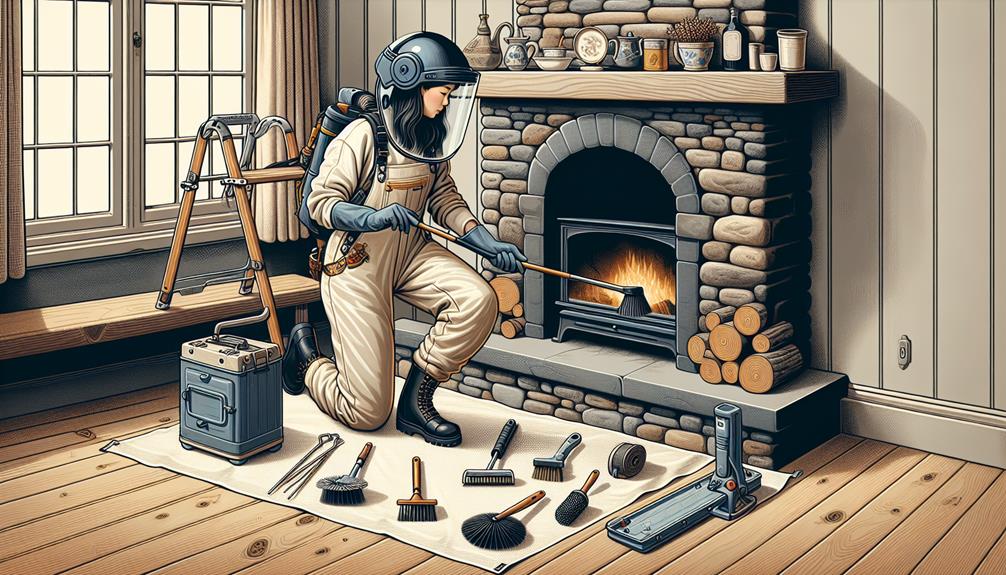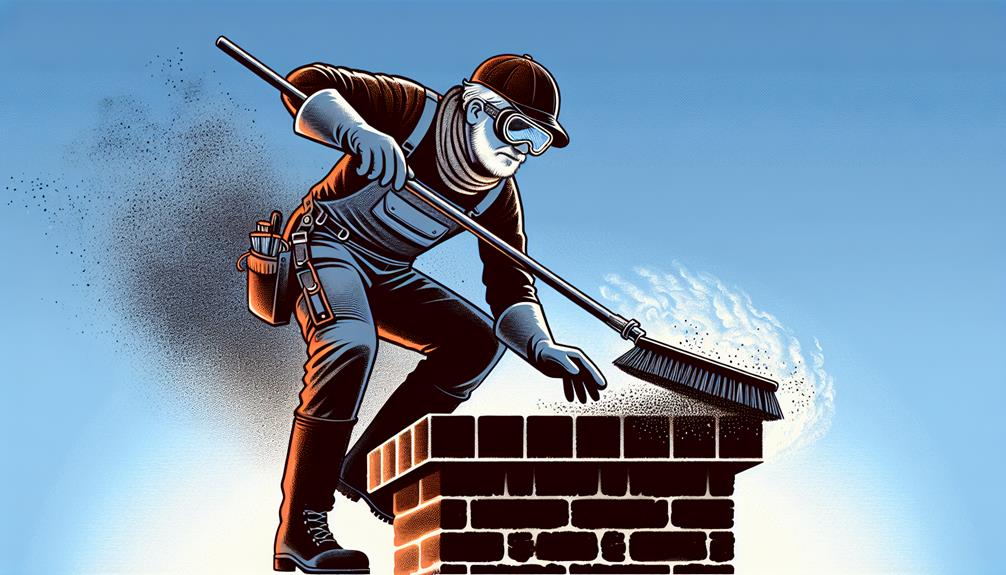Wondering if a clean chimney can help your fireplace work better?
Keeping your chimney flue clear is key for a safe and efficient fireplace.
So, what do you need to sweep a chimney effectively?
Let’s talk about the steps and tools you’ll need to make sure your chimney is ready for winter.
Chimney Flue Sweeping Tools
To clean a chimney, you need wire brushes, extension rods, and chimney cleaning logs. These tools help keep your fireplace safe and working well.
A certified chimney sweep knows the right tools to use to remove creosote, a fire hazard from burning wood. Use nylon brushes for stainless steel flues and polypropylene brushes for masonry flues to clear creosote.
Chimney cleaning logs can help break down creosote for easier cleaning. Extension rods help reach deep into the chimney for a thorough clean.
With the right tools, you can make sure your fireplace is safe and efficient.
Choosing the Right Brush Size
To clean your chimney flue properly, use a brush that matches the size of the flue opening. Using the right brush size is important for a thorough cleaning job. If the brush is too small, it may miss some areas, leaving behind creosote and debris. On the other hand, a brush that’s too big can get stuck and cause damage. Measure the diameter of the flue opening to choose the correct brush size.
Here’s a simple guide to help you pick the right brush size based on your flue diameter:
- For a 6-inch flue, use a 6-inch brush.
- For an 8-inch flue, use an 8-inch brush.
- For a 10-inch flue, use a 10-inch brush.
Selecting the proper brush size ensures a thorough cleaning and reduces the risk of issues during the cleaning process. Matching the brush size to the flue diameter is key to successful chimney flue cleaning.
Attaching the Brush to the Rod
To keep the chimney brush in place while cleaning the chimney flue, make sure to securely attach it to the rod. Use a brush that matches the flue’s diameter for best results.
Twist the brush onto the rod in a clockwise direction to lock it in securely. Ensure the brush is centered and balanced on the rod to maintain stability while sweeping.
Consider using a locking mechanism or screw to keep the brush in place during cleaning. This will prevent it from coming loose and help with a smooth cleaning process.
Inserting the Brush Into the Chimney
To clean your chimney effectively, use a brush that fits the flue size. Insert the brush carefully from the top or bottom, depending on your method.
Choose a brush with strong bristles to scrub off tough buildup. Move the brush up and down to dislodge creosote and debris. Repeat the motion several times to cover the entire flue surface.
Cleaning thoroughly is crucial for a safe and efficient chimney.
Sweeping From Top to Bottom
To clean your chimney:
Pick a wire brush that fits the flue size. Sweep from top to bottom to remove creosote and soot. Scrub the walls well to dislodge debris. Reattach the rain cap after cleaning to keep out debris and animals.
This method improves airflow and safety in your chimney. Remember, cleaning top to bottom is key to a functional chimney.
Using Up-and-Down Motion
When cleaning a chimney flue, move the brush up and down to loosen creosote and soot. Apply gentle pressure to remove stubborn deposits without harming the flue liner.
This method helps keep your fireplace or wood-burning stove safe and efficient.
Repeating the Cleaning Process
Make sure to clean your chimney every year to keep your fireplace or wood-burning stove safe and running smoothly. Regular cleaning helps prevent the buildup of creosote, a dangerous substance that can cause chimney fires.
By clearing out debris and obstructions annually, you ensure proper airflow and efficient operation of your fireplace or stove. This not only reduces the risk of fires but also extends the life of your chimney and keeps your home safe.
Neglecting chimney cleaning can lead to airflow issues, increased fire risk, and potential home damage. Remember to schedule a chimney cleaning at least once a year to maintain a safe and functional fireplace or wood-burning stove.
Inspecting for Damage
Check your chimney for damage by looking at the chimney liner, structure, cap, flashing, and flue for any wear, cracks, or blockages. Look for cracks in the liner, loose bricks, or water damage on the structure.
Make sure the chimney cap is in good shape without rust or missing parts. Check the flashing for gaps or rust that could cause leaks.
Use a flashlight to check for obstructions like bird nests or debris in the flue. If you see any significant damage, call a chimney sweep for help.
Disposal of Debris
After checking your chimney for damage, make sure to dispose of debris properly to keep your fireplace safe and clean. When handling creosote debris, put it in a plastic bag and throw it in the trash. Don’t burn creosote debris in your fireplace or chimney because it can easily catch fire. Use a broom and dustpan to clean up debris inside the fireplace to keep it neat.
After cleaning, securely reattach the damper to ensure good airflow in your chimney. You can use a shop vacuum to thoroughly clean any sooty areas. A shop vacuum can help remove debris that a broom and dustpan might miss.
Ensuring Proper Ventilation
Proper ventilation in your chimney flue is important for keeping your fireplace safe and working well. It helps smoke and gases like carbon monoxide move out of your home. Good ventilation also helps your fires burn cleanly without making too much smoke or causing health problems.
To make sure your chimney has good ventilation, you need the right-sized openings and clear passages for air to flow through. This stops smoke from coming back into your home and directs it up and out of the chimney.
Regular maintenance, like checking for blockages and ensuring good ventilation, is essential for a safe and efficient chimney system.
Frequently Asked Questions
Can I Sweep My Own Flue?
Yes, you can clean your chimney yourself if you have the proper tools and can safely reach all areas. Remember to use safety gear like harnesses and ladders. If you’re not sure, it’s best to hire a professional.
How to Clean a Chimney Flue Yourself?
To keep your chimney safe and working well, clean it yourself. Scrub the inside walls, use the dual-line method, protect the surrounding area, and dispose of creosote properly. Taking care of your chimney on your own helps prevent danger.
Is It OK to Sweep Your Own Chimney?
Cleaning your chimney is fine if you can reach all parts safely. Use the right tools and know-how, and be cautious. For tricky or very creosote-filled chimneys, it’s best to hire a professional. Regular upkeep helps avoid expensive fixes and fires.
How Often Should I Sweep My Flue?
You need to clean your chimney flue once a year if you use a wood stove or fireplace as your main heat source. This helps prevent chimney fires and keeps it working efficiently. Ask a certified chimney sweep for advice.
Conclusion
To keep your fireplace safe and working well, it’s important to sweep the chimney flue regularly. Use the right brush size, secure it to the rod, and sweep from top to bottom to remove creosote and debris.
Regular maintenance and inspections will help prevent chimney fires and keep your fireplace running smoothly. Enjoy cozy nights worry-free by taking care of your fireplace!











